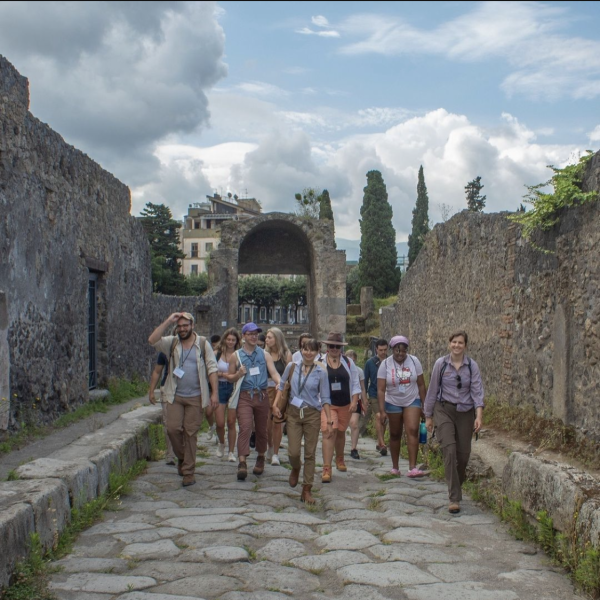Allison Emmerson, associate professor of classical studies at Tulane University, is the director of the Pompeii I.14 Project, Tulane’s very own archaeological site at Pompeii in Italy’s Campania region. In the field of archaeology, the project is a part of a movement pioneering new research technologies, and Emmerson herself is one of the few female archaeologists in the field to hold a coveted project director position.
But when looking back on the moment she decided to become an archaeologist, Emmerson recalled simply saying “Oh, I’ll do that.”
“I think I just pulled it out of the air,” Emmerson said. However, Emmerson also remembers an early interest in the ancient Greeks and Romans, as well as foraging for rocks and other treasures in her backyard. Archaeology was the perfect combination.
In college, she made the trek to the archaeological mecca: Pompeii. Nestled in the densely populated Bay of Naples and pinned under Mount Vesuvius’ looming shadow, Pompeii is a rarity among ancient phenomena — it has managed to permanently situate itself in the modern conscience.

“I thought it was the most incredible place I had ever been … And I never wanted to leave,” Emmerson said.
In January 2022, Emmerson received a permit from the Italian Ministry of Culture that allowed her to start her own excavation at Pompeii, and she decided to bring Tulane with her.
For this project, Emmerson knew she wanted a prominent technological presence, which she had plenty of experience with. When Apple released the iPad in April 2010, Emmerson was already using it in the field that June on another project. Currently, the Pompeii I.14 Project uses tools like LiDAR scanning, 3D models, data processing, drones and iPads to make life easier in the off-season when Emmerson and her team are analyzing the season’s material culture and stratigraphic layers.
“We can say, ‘Well, what [did] that trench look like on July 12.’ And then we can jump into the database or jump into the model. And we’re there,” Emmerson said.
For all its merits, archaeology is incredibly destructive. Once a site has been excavated, it can never be excavated again. It is for this very reason that archaeology is not considered a science — archaeologists cannot repeat their experiments, an essential component of the scientific method.
However, with technology, archaeologists can preserve sites virtually, allowing others in the future to “re-excavate” them. The meticulously recorded data is more accessible than ever before, and future archaeologists can revisit long closed sites and potentially draw new conclusions. This new mechanism for archaeology has prompted a somewhat controversial question in the community: could archaeology receive scientific status?
“To me, that’s not the goal,” Emmerson said. “We live in a culture that really prioritizes science over humanities, that sees the most valid types of data as scientific data.”
Emmerson acknowledges that some archaeologists might not agree with her, but said her project’s “overall goals and methods are humanistic.” Archaeology does not need to be science, and for a discipline concerned with uncovering the lives of past humans, the humanities is a fitting academic home.
Technology helps achieve distinctly humanistic goals. For Emmerson, all roads lead back to humans, and the Pompeii I.14 Project devotes special interest to those historically ignored, the ones on the fringes of society.
The physical site of the project is literally on the fringes of town, barely within the Porta Nocera gate at the southeastern edge of Pompeii. It’s a reflection of the circumstances for marginalized people in ancient Roman society, which includes the urban poor, the enslaved, the formerly enslaved and women.
Almost all Roman sources come from elite men, so while there is a healthy literary tradition during later Roman periods, not much is known about large swaths of the population. Archaeology at Pompeii is moving past uncovering the tragic events of 79 CE and pushing towards understanding a city in flux, one that includes the masses, previously unheard.
Pompeii I.14 is a leader of this movement, created with the intent to answer questions about the day-to-day lives of people living on the literal and metaphorical precipices of their city.
“What are they eating? What sorts of things are they leaving for the gods? What are they using to build the building?” Emmerson said, giving examples of some of the project’s guiding questions.
Illuminating the lives of those history has ignored is particularly poignant considering the project is headed by a woman, who until very recently were typically passed over for leadership roles. While women have long constituted the majority of archaeologists, they were confined exclusively to excavating and pottery washing. Today, more and more women have the opportunity to attain leadership positions, although most project leaders are still men.
“I really saw [the project] as a way that I could contribute to moving the culture of archaeology forward,” Emmerson said.
The Pompeii I.14 Project seems to perfectly encapsulate the fluidity of archaeology as an evolving discipline steadied by the humanities and stretched by modern technology. Emmerson and her team, which includes many undergraduate Tulane students, have created a project properly tasked to understand the lives of the forgotten in the most remembered city from the ancient world.






















Leave a Comment